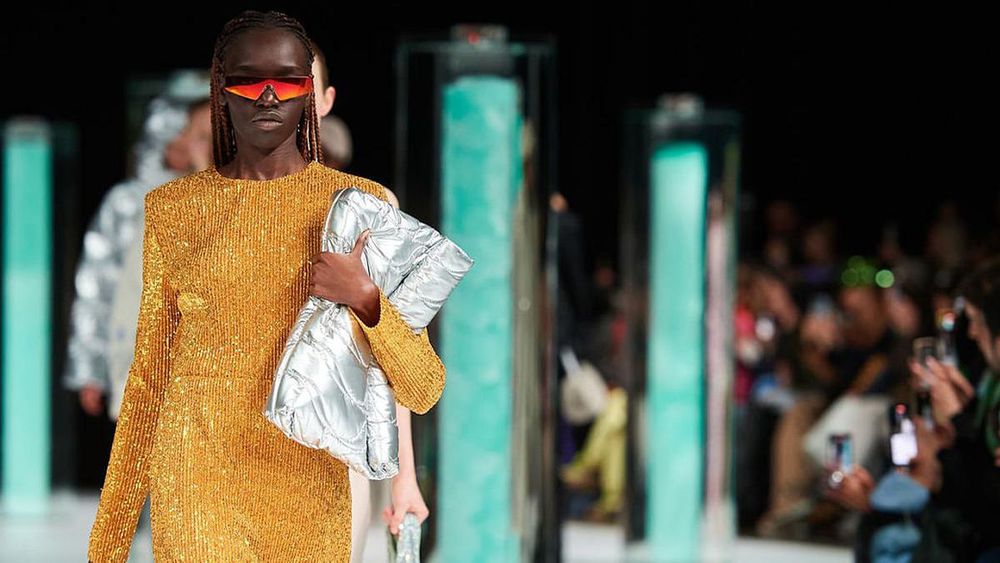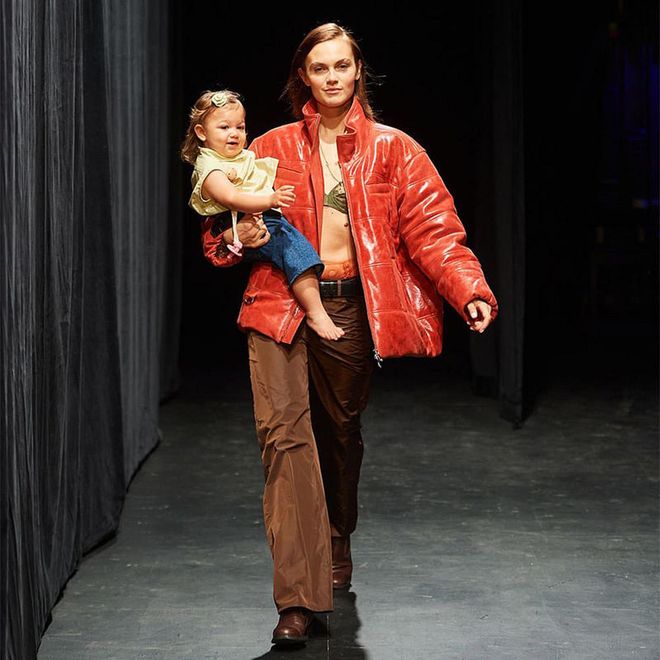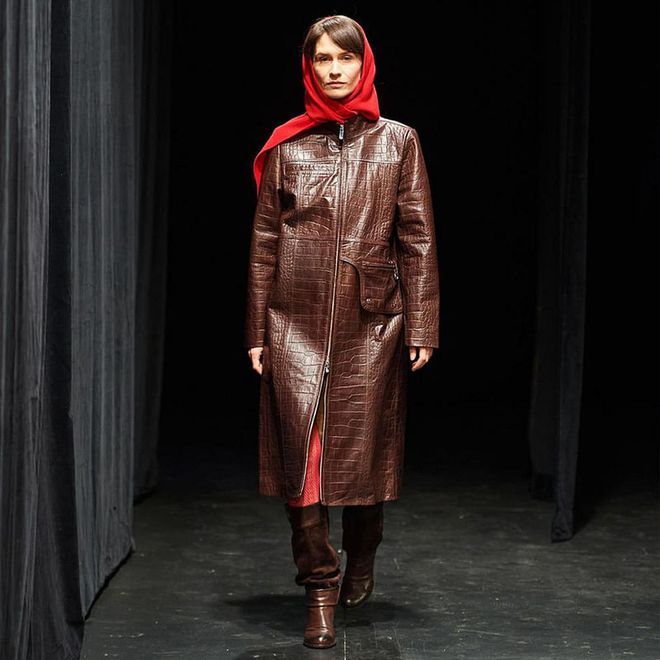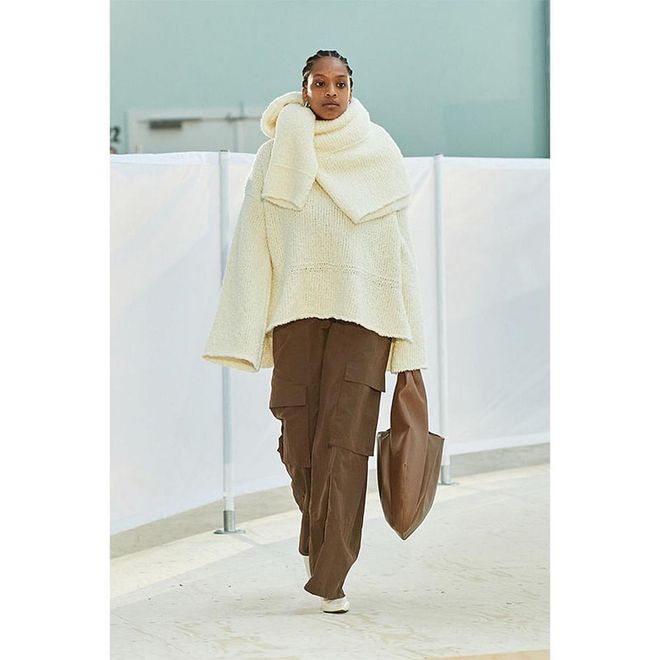Fashion Week Is Unsustainable. Can Copenhagen Change That?
This season, Copenhagen Fashion Week required designers to adhere to a set of sustainability standards. Will the rest of the world catch on?

Sak Potts staged one of the bigger spectacles on the second day of Copenhagen Fashion Week’s three-day Fall 2023 schedule. The Copenhagen-based label is best known for its leather and shearling trimmed “Foxy Coat,” 70s-inspired outerwear that sells for upwards of $1,400, and has been a street style must-have in every global fashion capital since it was first introduced shortly after the brand’s founding in 2014. The brand invited around 1,600 guests to Copenhagen’s jewelbox of a downtown amusement park, Tivoli Garden, where twinkling lights guided them through a winding garden to fill a two-level concert hall. Once seated, the Tivoli Youth Guard strode in toy soldier precision to line the theater’s aisles and play a triumphant processional march.
And then, at last, models walked onstage in a fall collection carrying over the sleek, utility-forward direction from last season, Spring 2023, when Saks Potts introduced a matured, working-woman’s rebrand. There was a matching red shirt-and-pants set, then a strapless dress, in a fabric laser-cut with constellation-like dots and swirls. Outerwear came in the hardworking shape of a black aviator jacket stuffed with shearling or a crocodile-like trenchcoat zipped all the way up to the model’s chin and topped with a red scarf wrapped around her head.
Related article: Front Row At London Fashion Week With Samsung

A family moment from Saks Potts’ collection.Photo: Courtesy of Copenhagen Fashion Week
A family moment from Saks Potts’ collection.

A look from Saks Potts’ collection.Photo: Courtesy of Copenhagen Fashion Week
A look from Saks Potts’ collection.
Then there were the families. One model, in a shiny red puffer jacket and swooshing brown cargo pants with a little olive bra top peeking out from beneath, carried her infant daughter; another model wore a half-buttoned brown shirt over matching trousers, cinched by a curved belt bag of that earlier croc-effect material whose double pockets draped over her pregnant belly. At the finale, the entire cast and both designers brought out chairs and posed as a group, Christmas-card style, downstage.
Fashion week, Saks Potts co-founder Cathrine Saks said in an interview, “shows everybody our DNA, our universe.” DNA was part of the family-themed show, with the exception of the brand’s first bona fide hit product—the foxy coat. It’s a hero piece the brand is moving away from, both aesthetically and in terms of its original materials. “Time changes, we're changing as well,” Saks said by way of explanation. Those changes involve phasing out materials like fur, a process that the brand announced last year—which the current fashion week wouldn’t have allowed anyway.
The move away from fur isn’t merely a choice—it’s something of a loose mandate. This is the first season of Copenhagen Fashion Week—which is not considered one of the big four global fashion weeks but increasingly draws attention for its designers’ poppy, influencer-friendly aesthetics—in which designers secured a spot on the official calendar by meeting 18 “minimum standards” for sustainability. Set by Copenhagen Fashion Week’s organizers and third-party sustainability consultants, the standards intend to function as a holistic checklist that nudges brands in a more environmentally and socially sound direction, at their physical runway shows, in their design studios, and at their stores. (So, if executed correctly, every facet of every brand.)
Included on the list: fashion shows should not create waste, with unrecyclable seat cards or setpieces that can’t be reused; designs should use at least 50 percent recycled materials; and there is a blanket ban on fur. These guidelines were first introduced three years ago, with a 2023 deadline to comply, and they’re the only form of eco-adjacent regulation implemented by a major fashion calendar. Twenty-eight designers made it onto the calendar this season; only one dropped out.
These well-meaning minimums open up a Pandora’s box of follow-up concerns. Fur is controversial, but petroleum-based faux substitutes attract just as much debate. Set pieces that are upcycled after one show could be re-made into an item with a postponed throwaway date. Through it all, there’s an underlying impetus for audiences to buy more than they really need, just because new products are released under a shiny spotlight. And to remind guests of as much, an anonymous crusader set up a scarecrow-like sculpture wearing a “Make Less” t-shirt and a grumpy frown outside several shows.
“Of course, yes, the most sustainable thing would probably be for Fashion Week to shut down,” Cecile Thorsmark, Copenhagen Fashion Week’s chief executive officer, said in an interview prior to the main event. “But that's just not going to happen.” The minimum standards’ requirements add a layer of accountability that stretches beyond event season and into designers’ day-to-day businesses, she added.
Interviews with one of Saks Potts’s creative heads and five other designers on the calendar, as well as with outside sustainability experts, reveal that most agree that Copenhagen Fashion Week’s first round of requirements are perceived as a welcomed baseline. Higher minimums than the outlines given this season could and should be expected of fashion labels, they said, but they also expressed that any acknowledgement of fashion’s damaging environmental impact is better than none at all.
From the front row, the latest instalment of Copenhagen Fashion Week looked much like what you’d see from the same view in any other city. All that revealed the zero-waste policy’s presence were the emailed show notes and the occasionally stripped-down sets. Aeron built a maze-like installation in the center of a cavernous art studio for models to wander through mid-show. At Remain, curtains strung along both sides of the runway were a screen for projecting the models’ silhouettes, lined up like leather-jacket clad warriors, before their final walk. Remain CEO and creative director Denise Christensen says the fabric used for the set will be incorporated into future collections; what isn’t will be donated to local design schools.
Related article: The Best Street Style From Copenhagen Fashion Week

The final walk at Remain. (Photo: Courtesy of Copenhagen Fashion Week)
The final walk at Remain.
Most designers this season could play within their preferred aesthetics while meeting the event’s standards. Eszter Áron of Aeron integrated her sourcing team into her design team so the two could be intertwined from the start, ensuring that material considerations were given equal weight to the designers’ imaginations. One notable result: a slick, cape-like raincoat made from cactus-derived fibers that closed the show. Rotate, best known for its ‘80s reminiscent party dresses and dramatic coats, shifted 60 percent of the sequins in its latest going-out lineup to “preferred materials” that sparkled just as much as previous collections’. Rotate’s creative directors Jeanette Madsen and Thora Valdimars, said they’ve tapped Danish and Dutch universities to help them research new production techniques that won’t dim their sparkle. OpéraSport cofounder Awa Malina Stelter said her label’s first collection in 2019 already met Copenhagen’s 2023 standards, with organic, GOTS-certified cotton and other fabrics made from 90 percent industrial waste.
A hard right turn into a new aesthetic because of the minimum requirements would have indicated a flaw in the program, Thorsmark, the fashion week’s CEO, said. “Otherwise, we're never going to convince the consumer that fashion that's produced more sustainably is just as attractive as the conventional alternative.”
“If anything, moving toward more sustainable practices makes the design process more exciting and brings a new dimension to our work,” said Stine Goya of her namesake label. She reports that 62% of the Aspen-rave collection shown on Wednesday, with bulbous printed puffer jackets and sheath dresses dripping in icicle-like embellishments, was made from “responsibly-sourced materials.”
“Slowly but surely, we’re getting closer to our goal of a fully sustainable collection, but it really is a journey and there are still necessary steps we need to take,” she added.
Related article: Introducing A New Look For The Ganni Girl

A look from Stine Goya’s collection. (Photo: Courtesy of Copenhagen Fashion Week)
A look from Stine Goya’s collection.
Everything designers mentioned is a well-intentioned effort. But as anyone who’s looked a little closer at where their clothes come from knows, it’s nuanced. The terms are loose: what are “responsibly-sourced materials,” for example, and who gets to decide? A lot is up for interpretation, and it’s clear that no two labels are meeting a standard like “at least 50 percent recycled materials” exactly the same way—or with a unanimously “better” alternative. Experts throughout the field all have different opinions. So did guests discussing this season’s collections outside the shows.
Chana Rosenthal, principal and founder at reDesign, a sustainability-focused consulting firm, found the requirements’ generality to be their biggest weakness. “The vagueness actually makes it more appealing in a way to brands, because part of the [sustainability] challenge has been brands saying they're doing something and then they’re not actually doing it,” she explained. “But also, it takes time. This isn't something that's easy to transition.”
The organizers are also aware of the minimum’s broad scope. Thorsmark says future seasons will come with new and more specific requirements as design technology improves and brands find the resources to adjust.
Lisa Bergstrand, founder of Bergstrand Consultancy, a firm that advises brands on sustainability initiatives, said there are bigger existential questions for any fashion week to answer while more granular adjustments are made. “For there to be meaningful change in the long term, I think a closer look needs to be taken at fashion’s focus on trends, which is one of the biggest drivers of overproduction and overconsumption.” It’s not merely how the clothes are made, but how they’re marketed, and how often, that contributes to consumer desirability.

A look from Aeron’s collection.Photo: Courtesy of Copenhagen Fashion Week
A look from Aeron’s collection.

The final look, including a cactus-derived rain jacket, from Aeron’s collection.Photo: Courtesy of Copenhagen Fashion Week
The final look, including a cactus-derived rain jacket, from Aeron’s collection.
There’s also the question of whether Copenhagen’s program can be, or would be, adopted elsewhere. American designers, many of whom already face immense financial pressures, may chafe at such measures. Still, standardized environmental checks seem to many experts like the most promising path to encourage suppliers to shift their priorities in a way that makes more eco-conscious production accessible to more labels.
For now, designers we spoke with are still optimistic that their adjustments will have a ripple effect in the big four fashion weeks’ direction. It could be challenging to bring larger markets on board with any sort of universal sustainability agenda, Rosenthal says, because the mega-brands of the flagship fashion weeks are well-entrenched in their ways. Still, some of the most influential designer stables have already developed policies transforming the products that make it to market, if not the shows where they debut. Kering began phasing out fur in the fall 2022 collections. LVMH set a goal to earn 25 percent of its profits from regenerative or circular products, instead of brand-new pieces, by 2030.
This month’s upcoming markets—New York, then London, Milan, and Paris—are dominated by far larger fashion houses with far bigger audiences. Copenhagen Fashion Week is growing in notoriety, but it’s still small. And in this industry, Cathrine Saks says, “You have a bigger voice when you're a bigger company.”
This article originally appeared in Harper's BAZAAR US.